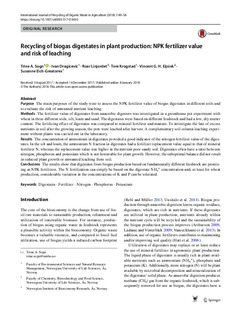| dc.contributor.author | Sogn, Trine Aulstad | |
| dc.contributor.author | Dragicevic, Ivan | |
| dc.contributor.author | Linjordet, Roar | |
| dc.contributor.author | Krogstad, Tore | |
| dc.contributor.author | Eijsink, Vincent | |
| dc.contributor.author | Eich-Greatorex, Susanne | |
| dc.date.accessioned | 2018-09-07T09:08:11Z | |
| dc.date.available | 2018-09-07T09:08:11Z | |
| dc.date.created | 2018-01-18T11:06:44Z | |
| dc.date.issued | 2018-01-08 | |
| dc.identifier.citation | International Journal of Recycling of Organic Waste in Agriculture. 2018, 7 (1), 49-58. | nb_NO |
| dc.identifier.issn | 2251-7715 | |
| dc.identifier.uri | http://hdl.handle.net/11250/2561403 | |
| dc.description.abstract | Purpose The main purposes of the study were to assess the NPK fertilizer value of biogas digestates in different soils and to evaluate the risk of unwanted nutrient leaching. Methods The fertilizer value of digestates from anaerobic digesters was investigated in a greenhouse pot experiment with wheat in three different soils; silt, loam and sand. The digestates were based on different feedstock and had a low, dry matter content. The fertilizing effect of digestates was compared to mineral fertilizer and manure. To investigate the fate of excess nutrients in soil after the growing season, the pots were leached after harvest. A complementary soil column leaching experiment without plants was carried out in the laboratory. Results The concentration of ammonium in digestates provided a good indicator of the nitrogen fertilizer value of the digestates. In the silt and loam, the ammonium N fraction in digestates had a fertilizer replacement value equal to that of mineral fertilizer N, whereas the replacement value was higher in the nutrient poor sandy soil. Digestates often have a ratio between nitrogen, phosphorus and potassium which is not favourable for plant growth. However, the suboptimal balance did not result in reduced plant growth or unwanted leaching from soil. Conclusions The results show that digestates from biogas production based on fundamentally different feedstock are promising as NPK fertilizers. The N fertilization can simply be based on the digestate NH4+ concentration and, at least for wheat production, considerable variation in the concentrations of K and P can be tolerated. | nb_NO |
| dc.language.iso | eng | nb_NO |
| dc.relation.uri | https://doi.org/10.1007/s40093-017-0188-0 | |
| dc.rights | Navngivelse 4.0 Internasjonal | * |
| dc.rights.uri | http://creativecommons.org/licenses/by/4.0/deed.no | * |
| dc.subject | Biogass | nb_NO |
| dc.subject | Biogas | nb_NO |
| dc.title | Recycling of biogas digestates in plant production: NPK fertilizer value and risk of leaching | nb_NO |
| dc.type | Journal article | nb_NO |
| dc.type | Peer reviewed | nb_NO |
| dc.description.version | publishedVersion | nb_NO |
| dc.rights.holder | © The Author(s) 2018. | nb_NO |
| dc.subject.nsi | VDP::Landbruks- og Fiskerifag: 900 | nb_NO |
| dc.subject.nsi | VDP::Landbruks- og Fiskerifag: | nb_NO |
| dc.source.pagenumber | 49-58 | nb_NO |
| dc.source.volume | 7 | nb_NO |
| dc.source.journal | International Journal of Recycling of Organic Waste in Agriculture | nb_NO |
| dc.source.issue | 1 | nb_NO |
| dc.identifier.doi | 10.1007/s40093-017-0188-0 | |
| dc.identifier.cristin | 1546153 | |
| dc.relation.project | Norges forskningsråd: 203402 | nb_NO |
| dc.relation.project | Norges forskningsråd: 226247 | nb_NO |
| cristin.ispublished | true | |
| cristin.fulltext | original | |
| cristin.qualitycode | 1 | |

